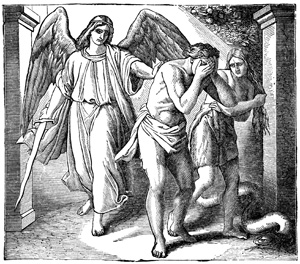From The Quiver, “Picturing the Angels” by Arthur Fish:
And He placed at the east of the garden of Eden cherubims, and a flaming sword which turned every way, to keep the way of the tree of life.” This, the first reference in Scripture to the heavenly hosts, brings involuntarily to the mind’s eye of the reader a conception more or less clearly defined of the angelic guardians of the gates of Paradise. From whence has this idea sprung? Not from the Bible itself; for only in the visions of the prophets and of St. John is any detailed description of angels given. When we are told of their appearance it is generally in the image of men, although in some cases they were recognised as being different from ordinary mortals. Thus Abraham, when he saw the “three men” standing by him, bowed himself to the ground and addressed himself to one as “My Lord”; and Lot did the same when the “two men” called upon him in Sodom. Jacob wrestled “with a man,” though in the same chapter we are told that he met “the angels of the Lord” and recognised them as such. Were they like those he had seen “ascending and descending” that wonderful ladder “the top of which reached to heaven”? It was “a man, with his sword drawn in his hand,” that Joshua encountered outside Jericho, but it was not until he announced his Divine ambassadorship that he was recognised as an angel. It was “an angel of the Lord” that stood in the way of Balaam, and appeared to Gideon, Manoah’s wife, and Elijah; but no description is given in either case. In the Psalms we have David’s poetic words, “He maketh His angels spirits, and His ministers a naming fire”; but it is not until we get to the New Testament that we find any attempt at the description of the angelic form. Then we are told by Matthew of the angel at the sepulcher that “his countenance was like lightning and his raiment white as snow.” Mark says of the same, “They saw a young man sitting on the right side clothed in a long white garment”; and Luke tells us “there were two men in shining garments”; while John’s account is of “two angels in white.” When Peter was released from prison, we are told that when the angel came “a light shined in the prison.”
Turning briefly to the prophetic visions of angels, we have Daniel’s description in the eighth chapter of his book—“There stood before me the appearance of a man” —and for the first time hear of the name Gabriel, referred to afterwords by Luke as the angel who appeared to Zachariah. In another vision recorded by Daniel the angel is described as “a certain man clothed in linen, whose loins were girded with fine gold of Uphaz; his body also was like the beryl, and his face as the appearance of lightning, and his eyes as lamps of fire, and his arms and his feet like in colour to polished brass.” In Isaiah’s vision the “seraphim” is described as having “six wings: with twain he covered his face, with twain he covered his feet, and with twain he did fly.” Upon none of these, however, is the popular angelic image based; and it is only when we turn to the pictorial efforts of early artists that we see from whence the idea has sprung.
We find from the first that angels have been represented as idealised human beings in general form, but with the addition of wings springing from the shoulders and halos round their heads—symbols of their higher nature; and all down the succeeding ages this has been tacitly accepted as the right and proper presentment of the celestial beings. Individual artists have now and again broken away from the tradition; but although their angels have been creatures of great beauty, they have been received with a feeling of resentment for not being in accord with the conventional treatment.
Milton’s glorious epic is looked upon by many almost as a history of the creation and fall of man; his vivid word-pictures of the unseen world seem so inspired that one feels as one reads that the author must like Stephen, have been afforded a glimpse of Heaven. The lines—
“. . . the Angelic throng,
Dispersed in bands and files, their camps extend
By living streams among the trees of life;
Pavilions numberless and sudden reared,
Celestial tabernacles, where they slept,
Fanned with cool winds; save those who, in their course,
Melodious hymns about the sovran Throne
Alternate all night long”—
present the scene so realistically that it comes almost as a shock to be reminded that he pictures, later on, the rebel angels employing the rude artillery of the poet’s own time against the hosts of Heaven. But this is simply what artists have done in their paintings. When imagination has failed, they have had to resort to “things that are seen”; it is simply an enforcement of the fact that the human mind is finite, and that the imaginative faculties are bounded on all sides by the realities of mortal existence. The limitation bears harder indeed upon the artist, for the poet can say with St. Paul, “Eye hath not seen, ear hath not heard, neither have entered into the heart of man” the glories of the unknown, and we accept the suggestion of something vast and grand with satisfaction; but the artist, limited by his materials, in his efforts to present the supernatural is compelled to resort to actualities, refining them as much as his art will allow, and using them as symbols of things higher and nobler.
Source: Fish, Arthur. “Picturing the Angels.” The Quiver. London: Cassell & Company, Ltd.,1897.
Visit Christian Image Source for free Angel Art.

